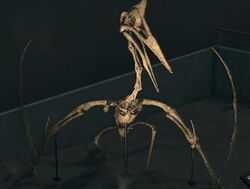Quetzalcoatlus
The Quetzalcoatlus is a three-part fossil in Animal Crossing: New Horizons.
At the museum[edit]
In New Horizons[edit]
When the player donates to Blathers or selects "Tell me about this!" in New Horizons, he will provide the following information about the fossil:
The Quetzalcoatlus can be found in the second room of the fossil exhibit in the museum.
As an item[edit]
In New Horizons[edit]
| Right quetzal wing | |
|---|---|
| Interactable | No |
| Sell price | |
| Colors | Brown
Brown
|
| Size | |
| Quetzal torso | |
|---|---|
| Interactable | No |
| Sell price | |
| Colors | Brown
Brown
|
| Size | |
| Left quetzal wing | |
|---|---|
| Interactable | No |
| Sell price | |
| Colors | Brown
Brown
|
| Size | |
Real-world information[edit]
Quetzalcoatlus is a member of the azhdarchids, highly advanced pterosaurs with toothless beaks and stiff necks. It lived in North America at the very end of the Cretaceous, 68 to 66 million years ago. It is among the largest flying animals ever discovered, with a wingspan of 10-12 meters. How well it flew depends on its weight, which scientists have been unable to agree upon, but some believe it was adapted for long-range soaring, able to travel at 130 km/h (80 mph) for over a week without resting.
More information on this topic is available at Wikipedia.
| Fossils | ||||||||||||||||||||||||
|---|---|---|---|---|---|---|---|---|---|---|---|---|---|---|---|---|---|---|---|---|---|---|---|---|
| ||||||||||||||||||||||||

